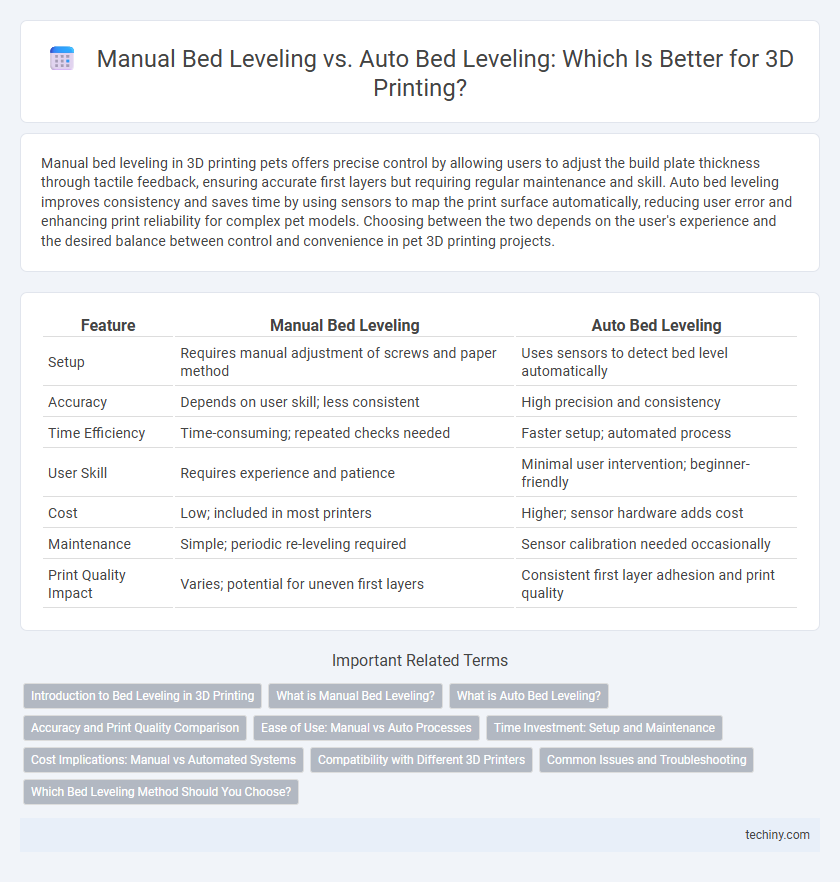Manual bed leveling in 3D printing pets offers precise control by allowing users to adjust the build plate thickness through tactile feedback, ensuring accurate first layers but requiring regular maintenance and skill. Auto bed leveling improves consistency and saves time by using sensors to map the print surface automatically, reducing user error and enhancing print reliability for complex pet models. Choosing between the two depends on the user's experience and the desired balance between control and convenience in pet 3D printing projects.
Table of Comparison
| Feature | Manual Bed Leveling | Auto Bed Leveling |
|---|---|---|
| Setup | Requires manual adjustment of screws and paper method | Uses sensors to detect bed level automatically |
| Accuracy | Depends on user skill; less consistent | High precision and consistency |
| Time Efficiency | Time-consuming; repeated checks needed | Faster setup; automated process |
| User Skill | Requires experience and patience | Minimal user intervention; beginner-friendly |
| Cost | Low; included in most printers | Higher; sensor hardware adds cost |
| Maintenance | Simple; periodic re-leveling required | Sensor calibration needed occasionally |
| Print Quality Impact | Varies; potential for uneven first layers | Consistent first layer adhesion and print quality |
Introduction to Bed Leveling in 3D Printing
Bed leveling in 3D printing ensures the build platform is perfectly aligned with the nozzle, which is crucial for print adhesion and quality. Manual bed leveling requires users to adjust screws by hand, using feeler gauges or paper to achieve an even gap across the print surface. Auto bed leveling uses sensors to automatically map the bed's topology, providing precise and consistent calibration that enhances print reliability.
What is Manual Bed Leveling?
Manual bed leveling in 3D printing involves physically adjusting the printer's build platform using screws or knobs to ensure the nozzle maintains a consistent distance from the bed across the entire print surface. This process requires careful calibration by the user, often utilizing a piece of paper or feeler gauge to check the nozzle gap at multiple points. Proper manual bed leveling is essential to prevent print defects like warping, poor adhesion, and layer inconsistencies, particularly in printers lacking auto-bed leveling sensors.
What is Auto Bed Leveling?
Auto Bed Leveling (ABL) is a technology in 3D printing that automatically measures and adjusts the build plate's surface to ensure optimal nozzle-to-bed distance. Utilizing sensors such as inductive, capacitive, or BLTouch probes, ABL creates a mesh map of the bed's topology, compensating for any unevenness during printing. This process enhances print adhesion, reduces calibration time, and improves overall print quality compared to manual bed leveling.
Accuracy and Print Quality Comparison
Manual bed leveling relies on user skill to adjust the print bed, often resulting in variable accuracy and inconsistent print quality due to human error. Auto bed leveling uses sensors to detect bed surface variations precisely, ensuring uniform nozzle height and improved first layer adhesion, leading to consistently higher print quality. The enhanced precision of auto bed leveling minimizes issues like warping and layer misalignment, making it the preferred choice for achieving superior 3D print accuracy.
Ease of Use: Manual vs Auto Processes
Manual bed leveling requires users to physically adjust the print bed using screws and a piece of paper to ensure proper nozzle distance, demanding patience and experience for consistent results. Auto bed leveling employs sensors and firmware to automatically detect bed surface irregularities, significantly simplifying the setup process and reducing calibration time. Printers equipped with auto bed leveling enhance user experience by minimizing manual intervention and improving print reliability.
Time Investment: Setup and Maintenance
Manual bed leveling requires regular user intervention to adjust the print bed, consuming significant time during setup and ongoing maintenance due to frequent recalibration needs. Auto bed leveling uses sensors to detect surface inconsistencies, dramatically reducing time investment by automating the calibration process before each print. This technology streamlines printer preparation, improves print quality consistency, and minimizes downtime compared to manual adjustments.
Cost Implications: Manual vs Automated Systems
Manual bed leveling in 3D printing significantly reduces upfront costs as it requires no additional hardware beyond standard printer components. Auto bed leveling systems introduce higher initial expenses due to sensors and advanced firmware but save costs over time by minimizing print failures and maintenance. Evaluating total cost of ownership, automated systems often deliver better long-term value despite their greater initial investment.
Compatibility with Different 3D Printers
Manual bed leveling offers broad compatibility across a wide range of 3D printer models, including older and budget-friendly machines that lack advanced electronics. Auto bed leveling systems require specific sensor hardware and firmware support, limiting their use primarily to mid-to-high-end printers with onboard controllers capable of handling sensor input. Compatibility depends heavily on the printer's motherboard, firmware, and physical design, making manual leveling a universal solution while auto leveling demands careful matching with printer specifications.
Common Issues and Troubleshooting
Manual bed leveling often faces common issues like uneven surfaces and inconsistent nozzle height, leading to poor first-layer adhesion and print warping. Auto bed leveling systems mitigate these problems by using sensors to map the build surface, though troubleshooting may involve recalibrating the probe and checking firmware compatibility to ensure accurate mesh generation. Both methods require periodic maintenance, but auto leveling reduces user error and improves print reliability when properly configured.
Which Bed Leveling Method Should You Choose?
Choosing between manual bed leveling and auto bed leveling depends on your 3D printer experience and project requirements. Manual bed leveling offers precise control but can be time-consuming and requires frequent adjustments, making it ideal for experienced users who prefer hands-on calibration. Auto bed leveling uses sensors to detect bed irregularities and adjusts the nozzle height automatically, enhancing print consistency and reducing setup time for beginners and those seeking convenience.
Manual Bed Leveling vs Auto Bed Leveling Infographic

 techiny.com
techiny.com